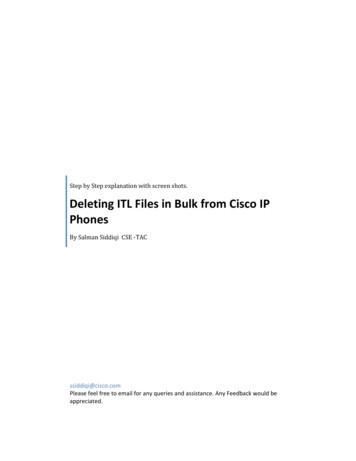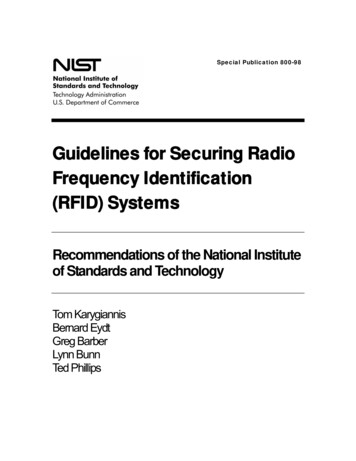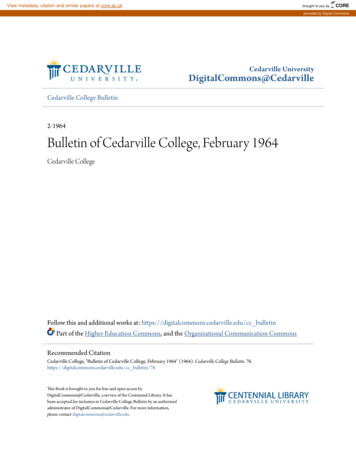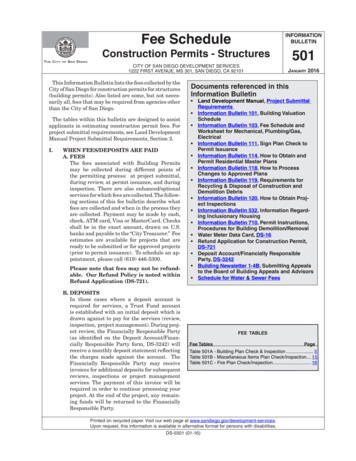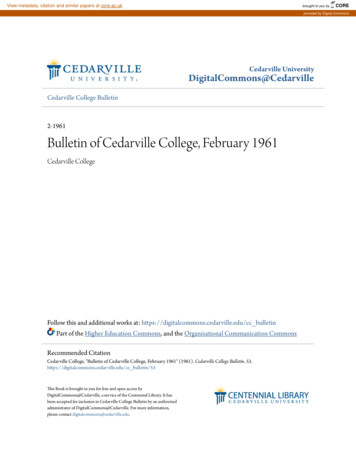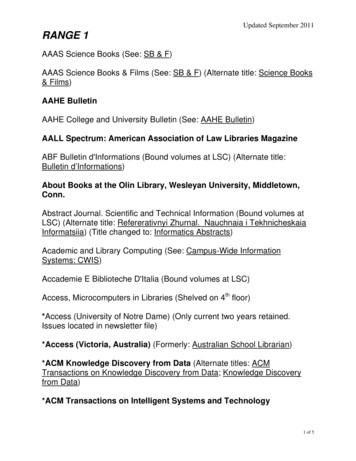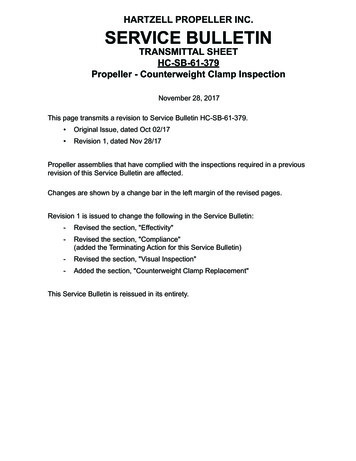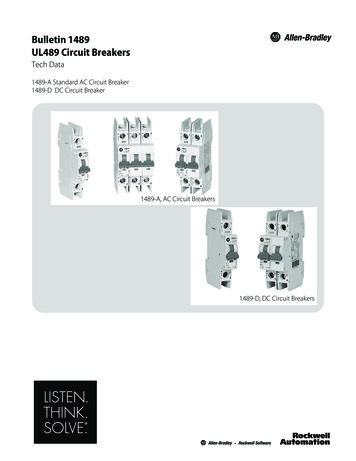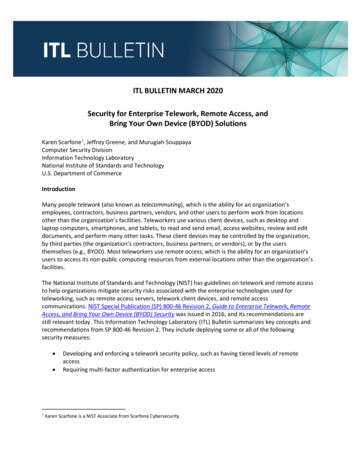
Transcription
ITL BULLETIN MARCH 2020Security for Enterprise Telework, Remote Access, andBring Your Own Device (BYOD) SolutionsKaren Scarfone 1, Jeffrey Greene, and Murugiah SouppayaComputer Security DivisionInformation Technology LaboratoryNational Institute of Standards and TechnologyU.S. Department of CommerceIntroductionMany people telework (also known as telecommuting), which is the ability for an organization’semployees, contractors, business partners, vendors, and other users to perform work from locationsother than the organization’s facilities. Teleworkers use various client devices, such as desktop andlaptop computers, smartphones, and tablets, to read and send email, access websites, review and editdocuments, and perform many other tasks. These client devices may be controlled by the organization,by third parties (the organization’s contractors, business partners, or vendors), or by the usersthemselves (e.g., BYOD). Most teleworkers use remote access, which is the ability for an organization’susers to access its non-public computing resources from external locations other than the organization’sfacilities.The National Institute of Standards and Technology (NIST) has guidelines on telework and remote accessto help organizations mitigate security risks associated with the enterprise technologies used forteleworking, such as remote access servers, telework client devices, and remote accesscommunications. NIST Special Publication (SP) 800-46 Revision 2, Guide to Enterprise Telework, RemoteAccess, and Bring Your Own Device (BYOD) Security was issued in 2016, and its recommendations arestill relevant today. This Information Technology Laboratory (ITL) Bulletin summarizes key concepts andrecommendations from SP 800-46 Revision 2. They include deploying some or all of the followingsecurity measures: 1Developing and enforcing a telework security policy, such as having tiered levels of remoteaccessRequiring multi-factor authentication for enterprise accessKaren Scarfone is a NIST Associate from Scarfone Cybersecurity.
Using validated encryption technologies to protect communications and data stored on theclient devicesEnsuring that remote access servers are secured effectively and kept fully patchedSecuring all types of telework client devices—including desktop and laptop computers,smartphones, and tablets—against common threatsRemote Access MethodsOrganizations have many options for providing remote access to their computing resources. The remoteaccess methods most commonly used by teleworkers are divided into four categories based on theirhigh-level architectures: tunneling, portals, direct application access, and remote desktop access.Tunneling involves establishing a secure communications tunnel between a telework client device and aremote access server, typically a virtual private network (VPN) gateway. The tunnel uses cryptography toprotect the confidentiality and integrity of the communications. Application software on the clientdevice, such as email clients and web browsers, can communicate securely through the tunnel withservers within the organization. Tunnels can also authenticate users and restrict access, such as limitingwhich systems a telework client device can connect to. The types of VPNs most commonly used forteleworking are Internet Protocol Security (IPsec) and Secure Sockets Layer (SSL) tunnels.A portal is a server that offers access to one or more applications through a single centralized interface.A teleworker uses a portal client on a telework client device to access the portal. Most portals are webbased—for them, the portal client is a regular web browser. The application client software is installedon the portal server, and it communicates with application server software on servers within theorganization. The portal protects communications between the client devices and the portal, and portalscan also authenticate users and restrict access to the organization’s internal resources. Most portalarchitectures today are SSL VPNs, and in fact, most SSL VPNs are portals, not tunnels.With direct application access, remote access is accomplished without using remote access software. Ateleworker can access an individual application directly, with the application providing its own security(communications encryption, user authentication, etc.). One of the most common examples of directapplication access is webmail. The teleworker runs a web browser and connects using HypertextTransfer Protocol Secure (HTTPS) to a web server that provides email access, and then the serverauthenticates the teleworker. For cases such as webmail that use a ubiquitous application client (e.g., aweb browser), direct application access provides a highly flexible remote access solution that can beused from nearly any client device.A remote desktop access solution gives a teleworker the ability to remotely control a particular desktopcomputer at the organization—most often, the user’s own computer at the organization’s office—froma telework client device. The teleworker has input control (e.g., keyboard, mouse) over the remotecomputer and sees that computer’s screen on the local telework client device’s screen. Generally,remote desktop access solutions, such as those using the Microsoft Remote Desktop Protocol (RDP) orVirtual Network Computing (VNC), should only be used for exceptional cases after a careful analysis ofthe security risks. The other types of remote access solutions described in this bulletin offer superiorsecurity capabilities.
Security ConcernsTelework and remote access technologies often need additional protection because their naturegenerally places them at higher exposure to external threats compared to technologies that are onlyaccessed from inside the organization. Major security concerns for telework and remote accesstechnologies include the following:A lack of physical security controls is an issue because telework client devices are used in a variety oflocations outside of the organization’s control, such as employees’ homes, coffee shops, and otherbusinesses. The mobile nature of these devices makes them likely to be lost or stolen, which places thedata on the devices at increased risk of compromise.Unsecured networks are used for remote access. Because nearly all remote access occurs over theinternet, organizations normally have no control over the security of the external networks used bytelework clients. Communications systems used for remote access include broadband networks, such ascable, and wireless mechanisms, such as Institute of Electrical and Electronics Engineers (IEEE) 802.11and cellular networks. These communications systems are susceptible to eavesdropping as well as manin-the-middle attacks to intercept and modify communications.Providing external access to internal-only resources such as sensitive servers will expose them to newthreats and significantly increase the likelihood that they will be compromised. Each form of remoteaccess that can be used to access an internal resource increases the risk of that resource beingcompromised.NIST’s Recommendations for Improving the Security of Telework and Remote Access SolutionsAll the components of telework and remote access solutions, including client devices, remote accessservers, and internal resources accessed through remote access, should be secured against expectedthreats. NIST recommends that organizations apply the following safeguards to improve the security oftheir telework and remote access technologies:Plan telework-related security policies and controls based on the assumption that externalenvironments contain hostile threats.An organization should assume that external facilities, networks, and devices contain hostile threats thatwill attempt to gain access to the organization’s data and resources. Organizations should assume thatmalicious parties will gain control of telework client devices and attempt to recover sensitive data fromthem or leverage the devices to gain access to the enterprise network. Options for mitigating this typeof threat include encrypting the device’s storage, encrypting all sensitive data stored on client devices,and not storing sensitive data on client devices. For mitigating device reuse threats, the primary optionis using strong authentication—preferably multi-factor—for enterprise access.Organizations should also assume that communications on external networks, which are outside of theorganization’s control, are susceptible to eavesdropping, interception, and modification. These types ofthreats can be mitigated, although not eliminated, by using encryption technologies to protect theconfidentiality and integrity of communications, as well as authenticating each of the endpoints to eachother to verify their identities.
Another important assumption is that telework client devices will become infected with malware;possible controls for this include the use of anti-malware technologies, network access control solutionsthat verify the client’s security posture before granting access, and a separate network at theorganization’s facilities for telework client devices brought in for internal use.Develop a telework security policy that defines telework, remote access, and BYOD requirements.A telework security policy should define which forms of remote access the organization permits, whichtypes of telework devices are permitted to use each form of remote access, and the type of access eachtype of teleworker is granted. It should also cover how the organization's remote access servers areadministered and how policies in those servers are updated.As part of creating a telework security policy, an organization should make its own risk-based decisionsabout what levels of remote access should be permitted from which types of telework client devices. Forexample, an organization may choose to have tiered levels of remote access, such as allowingorganization-owned computers to access many resources, BYOD computers to access a limited set ofresources, and BYOD mobile devices to access only one or two lower risk resources, such as webmail.Having tiered levels of remote access allows an organization to limit the risk it incurs by permitting themost controlled devices to have the most access and the least controlled devices to have minimalaccess.Ensure that remote access servers are secured effectively and configured to enforce telework securitypolicies.The security of remote access servers is particularly important because they provide a way for externalhosts to gain access to internal resources, as well as providing a secured, isolated telework environmentfor organization-issued, third party-controlled, and BYOD client devices. In addition to permittingunauthorized access to enterprise resources and telework client devices, a compromised server could beused to eavesdrop on communications, manipulate them, and provide a “jumping off” point forattacking other hosts within the organization. It is particularly important for organizations to ensure thatremote access servers are kept fully patched and that they can only be managed from trusted hosts byauthorized administrators.Organizations should also carefully consider the network placement of remote access servers; in mostcases, a server should be placed at an organization’s network perimeter so that it acts as a single pointof entry to the network and enforces the telework security policy before any remote access traffic ispermitted into the organization’s internal networks.Secure organization-controlled telework client devices against common threats, and maintain theirsecurity regularly.There are many threats to telework client devices, including malware, device loss or theft, and socialengineering. Generally, telework client devices should include all of the local security controls used inthe organization’s secure configuration baseline for its non-telework client devices, such as applyingoperating system and application updates promptly, disabling unneeded services, and using antimalware software and a personal firewall. However, because telework devices are generally at greaterrisk in external environments than in enterprise environments, additional security controls arerecommended, such as encrypting sensitive data stored on the devices.
Organizations should ensure that all types of telework client devices are secured, including desktop andlaptop computers, smartphones, and tablets. Security capabilities and the appropriate security actionsvary widely by device type and specific products, so organizations should provide guidance to deviceadministrators and users who are responsible for securing telework devices on how they should securethem.ConclusionMaking an organization’s resources remotely accessible enables telework but also increases securityrisk. Organizations should carefully consider the balance between the benefits of providing remoteaccess to additional resources and the potential impact of a compromise of those resources. To mitigaterisk, organizations should ensure that any internal resources they choose to make available throughremote access for telework purposes are hardened against external threats and that access to theresources is limited to the minimum necessary.Additional Resources: NIST Special Publication (SP) 800-46 Revision 2, Guide to Enterprise Telework, Remote Access, andBring Your Own Device (BYOD) SecurityNIST SP 800-114 Revision 1, User’s Guide to Telework and Bring Your Own Device (BYOD) SecurityNIST SP 800-77 Revision 1 (Draft), Guide to IPsec VPNsNIST SP 800-52 Revision 2, Guidelines for the Selection, Configuration, and Use of Transport LayerSecurity (TLS) ImplementationsNIST SP 800-111, Guide to Storage Encryption Technologies for End User DevicesNIST SP 800-124 Revision 1, Guidelines for Managing the Security of Mobile Devices in the EnterpriseNIST SP 800-40 Revision 3, Guide to Enterprise Patch Management TechnologiesNIST SP 1800-4, Mobile Device Security: Cloud and Hybrid BuildsNIST SP 1800-21 (Draft), Mobile Device Security: Corporate-Owned Personally-Enabled (COPE)National Checklist Program RepositoryITL Bulletin Publisher: Katherine GreenInformation Technology LaboratoryNational Institute of Standards and Technologykatherine.green@nist.govDisclaimer: Any mention of commercial products or reference to commercial organizations is forinformation only; it does not imply recommendation or endorsement by NIST nor does it imply that theproducts mentioned are necessarily the best available for the purpose.
Ensuring that remote access servers are secured effectively and kept fully patched Securing all types of telework client devices—including desktop and laptop computers, smartphones, and tablets —against common threats . Remote Access Methods. Organizations have many options for providing remote access to their computing resources.
